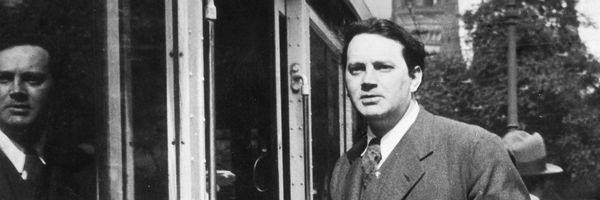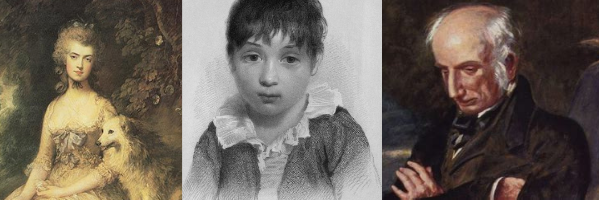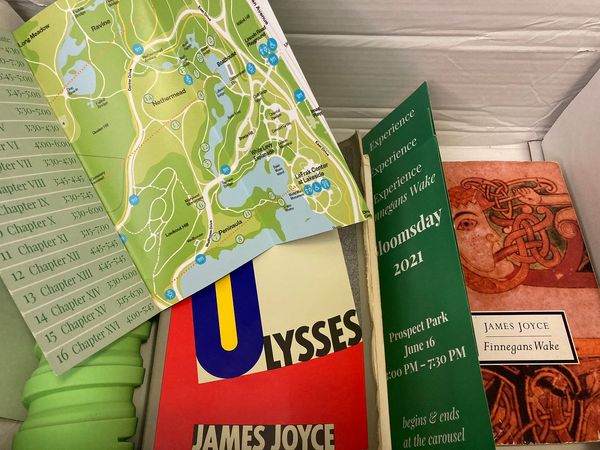(Hyperconnected) Solitary Reading

PreCursor Monthly — September 2020
This past Friday, I wrapped up my Literature & Hyperconnectivity series. This was designed, however, as a foundational overview. I will be returning to related ideas and texts in posts and videos and so on over time, and hope to also organize more live discussion events as those turned out to be highly productive. I have some ideas relevant to that ready to go, as well as a few ideas on unrelated topics. For now, these have no set schedule, but stay tuned!
In addition to this sort of intellectually rigorous content, one project I would like to attempt is live reading, with an open interest in whatever social possibilities that may entail in a virtual context.
According to a Pew Research study in 2019, approximately 20% of U.S. adults had listened to an audiobook that year, part of a steady increase from 11% in 2011. This coincides with a downward trend in book readership from 79% to 72%.
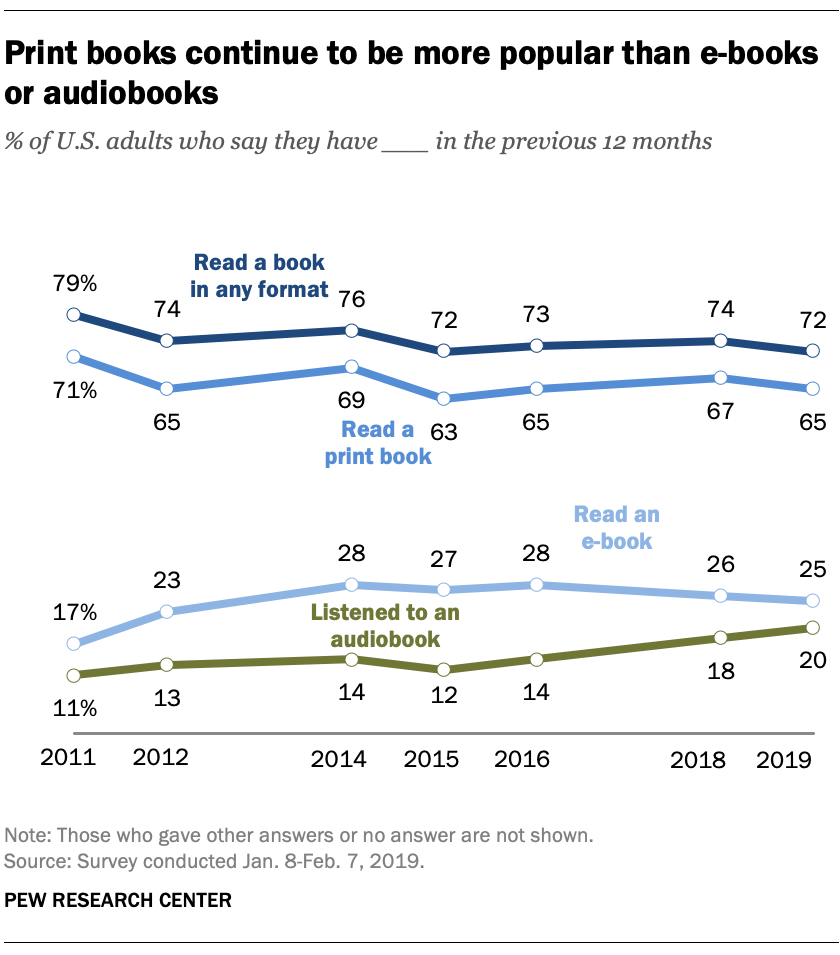
Audiobooks often boast high production quality with professional equipment and professional editing, on top of a base level of professional (sometimes celebrity) voice talent. This large industry, however, has a much humbler background: people reading aloud in public venues or in the home. In The Social Life of Books: Reading Together in the Eighteenth-Century Home, Abigail Williams discusses the role of this practice at a crucial historical moment.
Reading as a Social Activity in the Age of the Solitary Reader
As you can see in the chart above, 79% of U.S. adults were estimated to have read a book in any format in 2011. Though this has declined since, this remains the primary means by which people imagine books. Text is the default of how most books are written and accessed today, with the books being read primarily as a solitary, silent practice. In a culture that values efficiency, the act of subvocalization (pronouncing individual words mentally) is often critiqued as well. Solitary reading allows for extremely fast reading, and reading out loud to be understood by others requires being even slower and more pronounced than subvocalization. As literacy rose in England through the eighteenth and nineteenth centuries, one might expect people to have rushed to this new freedom, but Williams documents how this was not the case with extensive analysis as to why. A highly practical reason was that while literacy went up, access to reliable light and sustaining healthy sight did not improve so rapidly (64), but this does not encompass the full range of social and material practices in the period.
One key element of the lingering role of social reading was social performance. Williams notes, "Far from being a dying custom of preliterate communities, reading out loud well was at the very centre of polite accomplishment" (34). In this way, it was not just that people clung to existing traditions, but parts of England continued to be culturally invested in advancing theories of elocution. Reading was an opportunity to demonstrate cultivated taste in one's selection of books, an ability to read skillfully, a refined sensibility in detecting the shifts in emotional register in a text, and mastery of performance as you make the story and the feelings embedded therein come alive to an audience in various levels of engagement. This cultural value, however, fueled a wider set of domestic practices.
As is common with audiobooks today (as well as online videos, streams, podcasts, etc.), social reading provided background entertainment for recreation and work. Because books were relatively expensive and inaccessible as well, Williams points out that multiple readings were common practice (76), and so one could easily listen to scattered parts of a book, having already read or heard it multiple times. Though Williams sticks to eighteenth-century reading, it is worth expanding this point to note that this tradition was picked back up in the early 20th century through radio broadcasts. Though stories might benefit from complete listening, the nature of the technology was that people might pop in and out of listening as circumstances allowed.
When I got access to voicetweets, I posted a few sonnets by the underappreciated eighteenth-century poet Charlotte Smith: XLIV, LVIII, LXX, LXXVII. These times are somewhat subject to change, but I am aiming to do the following two readings this week, covering her two long poems (approximately one hour each, but you might tune in and out whenever):
- Friday, September 18, at 3 PM Eastern: The Emigrants (1793)
- Saturday, September 19, at 3 PM Eastern: Beachy Head (1807)
If there is further interest, I will plan more in the future, but this seems like a good start to get a feel for things.
Finnegans Wake – The Thing Itself
One literary text for which orality broadly and the radio in particular are acutely relevant is James Joyce's Finnegans Wake. There are, of course, oral traditions within literature, such as with ballads, which was the genre of the original "Finnegan's Wake." Joyce's text, though, was produced as a print book, with several sections released independently as print books while the full thing was still Work In Progress. Finnegans Wake is full of nearly constant portmanteau words – that is, words formed by combining other existing words, in this case drawing from a selection of dozens of languages, the complexities of which cannot always be captured in any one pronunciation. This structure makes the text notoriously difficult to read (both in the sense of doing so with comprehension, and in some cases on a surface level), but ultimately a delight to the ear. The text has, accordingly, been frequently read out loud, and sometimes also put to music.
Samuel Beckett wrote an excellent introduction and defense for the work while it was still in progress. Titled "Dante... Bruno. Vico.. Joyce" (in which the dots indicate centuries of distance), Beckett traces a lineage through the three other figures as justification for Joyce's experiment. Mostly, I wish to bring up the following comment:
Here form is content, content is form. You complain that this stuff is not written in English. It is not written at all. It is not to be read – or rather it is not only to be read. It is to be looked at and listened to. His writing is not about something; it is that something itself.
There is of course the relevant comment that the work is to be listened to, but also the bolder claim that the text is not about things, but is them. Within this frame, it is to be less frustrating that the content of the work is not so readily accessible, since the point is not centrally to understand a plot sequence, but instead there is a collection of things on display within what is on just one level a complex narrative sequence. There is a famous chart by László Moholy-Nagy which attempts to detail some of the overlapping levels of Finnegans Wake:
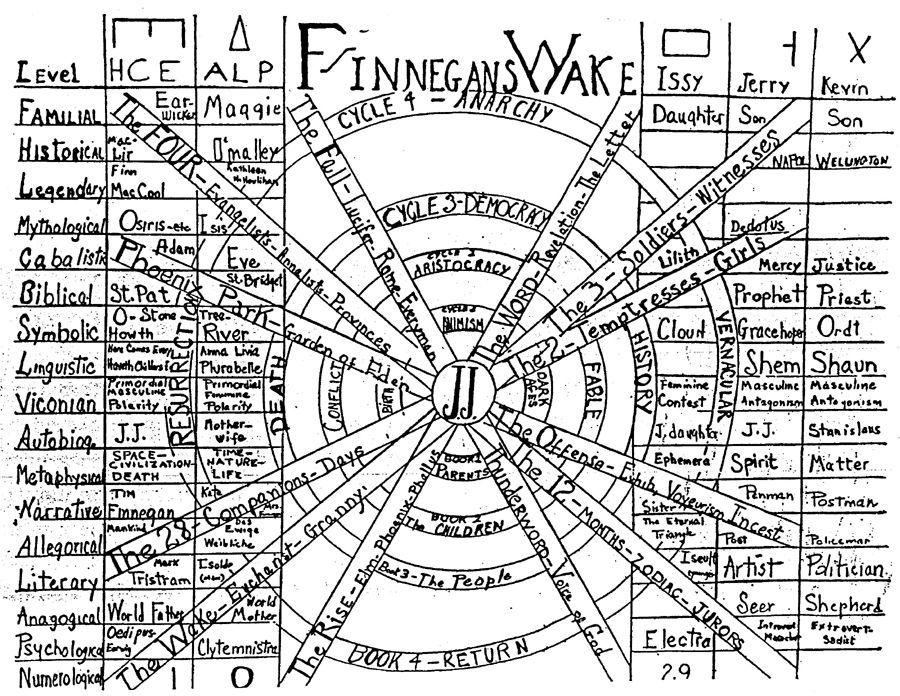
You have five main characters: Here Comes Everybody / Haveth Childers Everywhere (HCE) and Anna Livia Purabelle (ALP), who are married, their daughter Issy, and their two sons, Shem and Shaun. On a Cabalistic level, these are Adam, Eve, Lilith, Mercy, and Justice respectively, and similar dynamics on many other levels. HCE might, accordingly, appear at different times as Earwicker, Finn MacCool, Osiris, Tristan, biographical details of James Joyce himself, and so on. At the same time, we move through the four historical stages of Giambattista Vico's La Scienza Nuova, four stages in literary history, the four books of Finnegans Wake, and four stages of life, conflict, death, and resurrection. The diagonal branches reflect further recurring patterns in the work.
In short, the novel tells the story of a family, but a story and a family with many other simultaneous layers which are intended to come together to tell a nearly comprehensive account of all life, all history, all literature, all psychology, etc. The linguistic play provides freedom to engage with any aspect from anywhere as relevant. What does a comprehensive story entail, though? That requires a centralizing vision, and Joyce's is endless cycles of loss, growth, and rebirth, coming again and again to this complex world through compounding traditions, generations, epochs, and so on. I wrote in-depth on one chapter of Finnegans Wake and one chapter of Ulysses for Bloomsday back in June. If you'd like to read more: "Always Again Another Bloomsday," a playful title which imagines the sort of progression from A to A to A then suddenly to B which is at the heart of Joyce's vision.
As Joyce writes in Chapter 3 of Ulysses: "Hello. Kinch here. Put me on to Edenville. Aleph, alpha : nought, nought, one." How does that one come from nothingness followed by more nothingness, as in the creation of Eden? Let's scroll back one more sentence earlier for that: "Gaze in your omphalos." The omphalos (or navel) directs our attention to reproduction, yet this is also navel-gazing (omphaloskepsis), an ancient form of meditation which is now used derisively to refer to worthless overthinking, and Joyce's Stephen Dedalus here is quite the overthinker.
The Historical Futures of Poetry
Speaking of Fins who are also Biblical figures and histories which are also the future, I recently read E.L. Brooks' poetic text Phineiad: A Brief History of the Future, self-published May 2020. The work is premised in a sense that our current age no longer sees "value in marriage, in property, in sacrifice, in praise, in any other constant of human life." Brooks, accordingly, takes up the value of poetry, and in particular seeks to revive traditions of medieval Romance and Allegory. In the Book of Numbers, Phinehas ends a plague. Brooks' Fin-turned-Phinees does similar within an allegorical tale of current social and political ills, with an emphasis on courage and the steadfast pursuit of great work even in the face of suffering.
I find ambition, particularly literary ambition, pretty inherently appealing. A fifty-page poem in an unpopular mode is immediately a bit of a treat, but made more so by Brooks' prefatory comment that this is merely "something of a microcosm of what I hope someday may be done on a grand scale." Having just read a series of short poems written as assorted self-contained experiments, I found this clear sense of project enjoyable – not just in concept, but seeing it through over fifty pages, entirely through a single, fixed five-line stanza form. One excellent element of our present moment is that self-publishing allows for the immediate sharing of any project, outside of any formal systems of oversight, and to form one's own audience freely.
I was reminded, though, of Harold Bloom's 1969 essay "The Internalization of Quest-Romance." As Bloom presents it, medieval Romance has not gone away, but was instead internalized by the British Romantic poets, whose massive influence is still with us. As he writes, "The dreadful paradox of Wordsworth's greatness is that his uncanny originality, still the most astonishing break with tradition in the language, has been so influential that we have lost sight of its audacity and its arbitrariness" (7, as published in Romanticism and Consciousness). And as Bloom describes the larger shift, "There are thus two main elements in the major phase of the Romantic quest, the first being the inward overcoming of the Selfhood's temptation, and the second the outward turning of the triumphant Imagination, free of further internalizations" (17). The quest becomes the movement of the poet across poems, with the ends of the quest not being the poems themselves but a more imaginative vision. Amid troubled times, the paradise is to be found within, and so the poems offer a healing power to others through promoting a reader's own parallel growth.
It is possible we have renewed need for such classic externalized quest narratives. Phineiad offers us one such vision of that, and I am always all about the multiple futures of literature.
Riverrun – Limited and Unlimited
One future of literature is certainly some form of electronic literature, which is part of why these monthly introductions are so valuable. This work deserves much more focused attention at a later date, but in thinking of histories and the future at once, you should be aware of the first hypertext novel, afternoon, a story, by Michael Joyce.
The work was initially released as a work-in-progress first run through a startup comprised of Joyce, Jay David Bolter, and John B. Smith. It was called Riverrun Ltd., a reference to the famous first word of Finnegans Wake with James Joyce's interest in endlessly flowing waters seeming appropriate for the form Michael Joyce was in the process of creating. A hypertext novel replaces linear pages with digital lexias, connected not in a singular sequence, but in a web of links, allowing for a non-linear narrative. Joyce, further, added what he called guard fields, tags which require the reader to have accessed specific sections of the text before some hyperlinks become accessible. In this way, one is not just cycling through the same text endlessly, but new cycles allow for new directions.
In Finnegans Wake, the "riverrun" is not limited. The line is famous, in part, because it loops together with the ending, with the last line continuing on seamlessly with the first. With Finnegans Wake, it is famously riverrun unlimited. Does Michael Joyce's hypertextual form offer him the same claim? He writes in his introductory remarks that closure is "a suspect quality" in any fiction, but the idea of closure in afternoon has nevertheless been an interesting line of scholarly inquiry, most prominently through the work of J. Yellowlees Douglas.
One way in which (great) texts are unlimited is that they resist exhaustion. As regards afternoon, I argue that the currently popular framing of the text around the Modernist Joyce and Postmodernist theories of literature offers an incomplete account of the text's most valuable experiments. As I show elsewhere, while Joyce enjoys his shared name, Johann Wolfgang von Goethe, Mary Shelley, Percy Shelley, John Keats, Lord Byron, and William Wordsworth are all notable precursors in the creation of afternoon and its underlying storytelling system. I got to present some of that research at the Electronic Literature Organization conference in Cork, Ireland in 2019 and hope to have something readable on the horizon soon.
In the meantime, you can get an immediate introduction to the text itself through a reading hosted by the Electronic Literature Lab, with a rotating cast of scholars and artists working through the text, including Michael Joyce himself.
Around the Web
- For more social reading on the electronic front, the Electronic Literature Lab is also hosting a series of live traversals of electronic texts. You can view the already-completed first event, which covered the interactive detective game A Sucker in Spades (1988), here, or click that first link for a full schedule of monthly events.
- The World Wide Webb is an online, browser-based exhibition, designed for smartphones. You can view a brief introduction here, and then click "Visit Online Exhibition" on the right.
- With Poetweet, you can input the name of your Twitter account (or any Twitter account), and the site will generate a sonnet, rondel, or indriso based on posting history. (You do not need to give any account access for this.) This goes back several years, but was introduced to me by Charlotte Geater, as part of our live discussion in August.
This was sent out as my September newsletter. I send out similar updates on new, electronic, and classic literature in conversation at the beginning of each month, along with glimpses into interesting scholarly projects and online content. To receive future updates directly in your inbox, sign up below:



